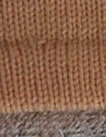Navigate my site!
 This
page describes how to create a double hem on a single bed knitting
machine.
I used this on my Cable V-Neck Vest.
This is a very inconspicuous hem that can be made on a single bed
machine. A few stitches of a 1" deep hem are illustrated at
right.
This
page describes how to create a double hem on a single bed knitting
machine.
I used this on my Cable V-Neck Vest.
This is a very inconspicuous hem that can be made on a single bed
machine. A few stitches of a 1" deep hem are illustrated at
right.
When I make a double hem, I always set The Knitting Fiend hem and cuff options to permit increasing and decreasing at the cuffs and hem. I do this to prevent the hem from spreading. Although the schematics will show the hem drawing in, you will not notice this at the knitted hem. If you examine carefully, you will see that I increased stitches after the hem. The extra stitch is visible in the picture because I specifically took a close up of the increase!
The Knitting Fiend directions will tell you the number of stitches for the front portion of the hem. But, you must create the back portion and a turning row to make a double hung hem. This page will also do all the calculations to determine the number of rows you need to knit and tell you when to adjust the tension dial. It will also indicate the location of the carriage at key points.
Knitting the hem has a number of steps. The first step, "Make Waste Yarn Base" is optional. If you don't make the waste yarn base, then you don't need to remove it. I do recommend using the waste yarn because I find it easier to see the loops when hanging the EON row.
You should swatch a hem over a small number of stitches before casting on the full number of stitches. After swatching, verify that the fold row falls on the fold.
Some abbreviations are defined at the end of this document.